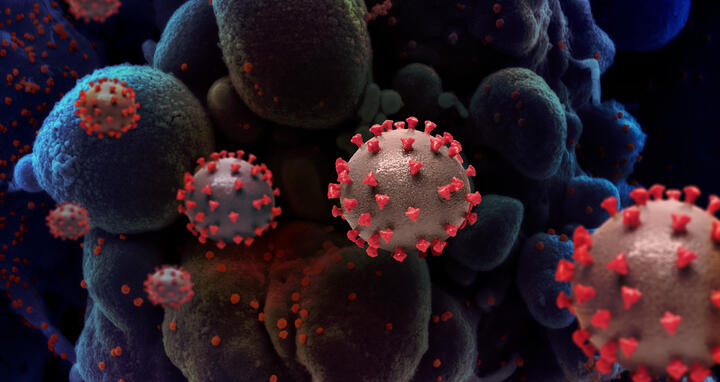COVID-19: Scientific triumphs and lingering questions
Five world-class experts, including the lead developer of the German-based BioNTech vaccine, shared their insights about the COVID-19 pandemic during a half-day, virtual symposium hosted by the Helmholtz Association consortium for Immunology and Inflammation (I&I) and the Max Delbrück Center for Molecular Medicine in the Helmholtz Association (MDC).
The I&I COVID-19 Symposium on March 3 was one of the most successful scientific symposia hosted by the MDC, attracting about 2,000 researchers, journalists and members of the public.
The incredible success of this scientific approach in generating therapeutic antibodies and vaccines in record time is a real scientific triumph.
The event was an opportunity to hear directly from key scientists tracking the spread of the pandemic, investigating coronaviruses, immune responses, variants and vaccines. It was also an opportunity to dispel misinformation and underscore the scientific community’s role in responding to the public health crisis.
“There is the obvious key role of science, and in particular the study of the immune system, in overcoming the pandemic,” said Professor Klaus Rajewsky, who heads MDC’s Immune Regulation and Cancer Lab and co-hosted the event. “The incredible success of this scientific approach in generating therapeutic antibodies and vaccines in record time is a real scientific triumph.”
It shows that we need long-term investment in both basic and translational research to be able to address such challenges.
Professor Michela Di Virgilio, who heads MDC’s Genome Diversification & Integrity Lab and co-hosted the event agreed: “During this pandemic, we see scientific advances that build on decades of research. It shows that we need long-term investment in both basic and translational research to be able to address such challenges.”
First, the not so great news
Professor Michael Meyer-Hermann of the Helmholtz Centre for Infection Research has been advising the German government on the pandemic’s spread and public health response. He and his team have developed a mathematical model to map the spread of infection. He detailed the numerous factors they take into account, and how well the model’s predictions have matched reality.
However, that is beginning to change: the model predicted cases should still have been dropping in late February and early March, while the actual number in Germany was creeping higher. “Other simulations are also underestimating the current data, which means there is something going on which we didn’t understand yet and makes the situation even worse,” Meyer-Hermann said.
Michael Meyer-Herrmann, @simmgroup at @Helmholtz_HZI: "The real numbers are actually beginning to look worse than our models would predict it for #Germany with the new variant. It's concerning and means that there is something going on that we do not understand yet." #mdcBerlin pic.twitter.com/Z39RUyqFHq
— Max Delbrück Center for Molecular Medicine (@MDC_Berlin) March 3, 2021
Still, with the best available information, the model is showing a dramatic increase in cases in late March and into April as social distancing measures are relaxed and more infectious variants spread. “Vaccinations will come too late to prevent a third wave at least in European countries,” he said.
Meyer-Hermann and others are recommending that governments take a strong, proactive approach to get ahead of the wave. Studies with economists at the ifo Institute in Munich have shown that controlling the pandemic through strict lockdowns to reach an optimal infection rate of about 0.8 – which is called the reproduction number, or number of people one sick person infects – is better for the economy in the long-run.
“If we have a higher reproduction number, we prolong the whole lockdown and also increase costs to the economy,” Meyer-Hermann said, pointing to additional historical evidence: U.S. states that took more decisive actions during the 1918 Spanish flu pandemic had a better economy afterwards than states that did not. “Economy is only possible if we control the virus,” he said.
Coronaviruses through the years
Professor Susan R. Weiss, of the Perelman School of Medicine at University of Pennsylvania, has been studying the basic biology of coronaviruses for decades. There were only about 60 scientists at the first international conference on coronaviruses held in Würzburg, Germany in 1980 “and that was about the whole field,” she said. The field has grown a lot since then, first with the emergence of SARS-CoV-1 in 2002 and now it has exploded with this pandemic.
Susan R. Weiss|@weisssr, Perelman School of Medicine at the University of @Penn, provides an overview on #CoronaResearch, which is nothing very recent. It started when OC43 occured in the 1960s – the human #coronavirus that infects humans as well as animals. #COVID19 #Corona pic.twitter.com/nuc7NRLvIt
— Max Delbrück Center for Molecular Medicine (@MDC_Berlin) March 3, 2021
Weiss shared an overview of the structure of coronaviruses, their genomes, how they replicate inside their hosts and various pathways that can be explored to block their activities. Coronaviruses, which include MERS, SARS-CoV-1, and common cold viruses, all have a similar genome structure. While genetic differences lead to distinct reactions in the animals or humans they infect, many proteins are similar, or conserved, across the virus types. For example, proteins involved in helping the virus replicate, protecting it from making mistakes during the replication process, or interfering with host immune responses.
“All of these are really conserved, so an antiviral against one of them is very likely to work against most, if not all, coronaviruses, and even future coronavirus should there be another epidemic or transmission from humans to animals,” Weiss said.
She said it is possible other coronaviruses have already spilled over from bats to humans, but perhaps went undetected because people didn’t get as sick or it didn’t spread as far. It’s also possible more strains could arise in our future. “I think we have to go on the premise that there will be more and we should be prepared,” she said.
Why is this virus life-threatening for some people?
In the case of COVID-19, it has become clear the main risk factor for severe illness and death is age. But there are also exceptions to the rule: elderly people who are asymptomatic, and young people dying. Professor Jean-Laurent Casanova, of The Rockefeller University and Howard Hughes Medical Institute, and his collaborators, are working out the mechanisms that lead some patients to have a life-threatening reaction to SARS-CoV-2 infection, when most patients do not.
They recruited more than 5,000 patients from all over the world who agreed to have their entire genomes sequenced. A small fraction had “inborn errors” or single-gene mutations since birth that affect a vital part of the innate immune system, called type I interferons, which are proteins that help alert the body to the presence of viral invaders.
Using “genetics as a compass,” they then began to look for signs of something blocking the interferon alert system in more patients with severe reactions to COVID. They found around 10 percent of their study participants with severe COVID had pre-existing, undetected “auto-antibodies,” which are antibodies that attack a person’s own healthy proteins, working specifically against type I interferons.
“The data shows that if you carry these auto-antibodies and you are infected with SARS-CoV-2, you cannot have a silent infection and you will have a critical form of pneumonia,” Casanova said.
Why is #COVID19 asymptomatic in many people but life-threatening in others? Jean-Laurent Casanova from @RockefellerUniv is looking for genetic and immunological mechanisms of innate immunity that causes this. Certain auto-antibodies are one part of the answer. #mdcBerlin #Corona pic.twitter.com/Kk7s18HvWm
— Max Delbrück Center for Molecular Medicine (@MDC_Berlin) March 3, 2021
Further research is needed to understand the cause of the auto-antibodies, and why they appear to increase with age. Casanova wonders if they are behind a much higher proportion of severe COVID cases than understood so far. The good news is that these auto-antibodies can be tested for, and there is a commercially available treatment that can help circumvent their effects. The research is still going through the review and publication process, so stay tuned for more details.
Your immune system remembers, and adapts
Professor Michel C. Nussenzweig of The Rockefeller University and Howard Hughes Medical Institute has been tracking antibody levels and how they change over time in patients recovered from SARS-CoV-2 and those who have been vaccinated. There’s good news. He and his colleagues found that while serum antibodies, which are produced in response to an infection, drop markedly after six months, the levels of memory B cells hold steady. The antibodies that these memory cells produce upon re-exposure to the original or a related virus represent the immune system’s long-term memory.
Not only do the memory B cell antibodies remember the virus, they continue to mutate and evolve, creating a diverse array of new antibodies. After one month of infection, some patients had versions of B cells that did not respond to certain SARS-CoV-2 variants. After six months, the B cells saw almost all the variants. “Antibodies can evolve and become more potent,” Nussenzweig said. “Adaptive immunity is critical to clearing the virus.”
Michel C. @NussenzweigL from @RockefellerUniv says recovered and vaccinated individuals can become infected with #SARSCoV2-variants. BUT most of them will not become severely ill because we produce four classes of antibodies and will still be able to fight the infection. #COVID19 pic.twitter.com/lGxkJLp3a0
— Max Delbrück Center for Molecular Medicine (@MDC_Berlin) March 3, 2021
He and colleagues have worked on isolating and cloning antibodies from COVID-19 patients and those who have been vaccinated, to find which antibodies are most effective and could be used for treating individuals at high risk for developing serious disease. Much like the treatments he developed for HIV, he recommends combining two types of antibodies that bind to different parts of the virus, interfering with its function. “If you want to create a monoclonal antibody cocktail that is resistant to mutation, then you might want to combine antibodies that see separate [binding] sites,” he said.
He observed that many of the SARS-CoV-2 variants detected so far, regardless of where they originated, are showing the exact same mutations, perhaps revealing the virus has a limited repertoire. He is optimistic that vaccines will help keep people out of the hospital, in large part thanks to those long-term, adaptive memory immune cells. Even if people do become infected with a variant, he anticipates they will be able to fight the virus. “In most cases, I believe you will not get terribly sick,” he said. “You’ve already developed that memory response – it’s not so specific that you can’t handle a variant.”
mRNA to the rescue
In January 2020, when the first reports of a novel virus emerged, Professor Uğur Şahin and his colleagues at BioNTech paid close attention. When asymptomatic transmission was observed, they worried it had potential to result in a pandemic and moved quickly to adapt their mRNA vaccine under development for personalized cancer treatments to COVID-19.
Even though very little was known about SARS-CoV-2 at the time, the team set to work screening more than 20 different vaccine designs, drawing on their expertise built up over decades working to improve the efficacy of mRNA vaccines. The different designs all followed the same general principle: deliver a snippet of viral mRNA to the body, which is transcribed into proteins that are a small part of the virus. These proteins elicit an immune reaction so the body is then prepared to fight off the real thing when and if it encounters it.
The BioNTech team zeroed in on using either mRNA that codes for the full spike protein that gives coronaviruses their distinct shape, or a small section of the spike that is a key binding site. They tested both versions in mice, then in monkeys, to see what sort of immune response occurred. Human trials were launched in Germany and then shortly thereafter in the US with Pfizer. Both versions elicited similar immune responses, but the researchers found the full spike protein was the way to go – the immune response, particularly among T cells that target and kill virus-infected cells, could be better tailored based on the amount of vaccine given, and led to better antibody responses in the elderly.
Even before the clinical trial results were in, BioNTech began ordering large amounts of raw materials like synthetic lipids that would be needed to produce billions of vaccine doses. They placed the orders in April 2020, which took about nine months to be delivered. “Everything was done at cost and at risk,” Şahin said.
Ugur Sahin from @BioNTech_Group: "In 2019, we produced 10,000 doses of our #mRNA vaccines against #cancer. In 2021, we will produce 2 billion doses of the #SARSCoV2 vaccine. This is a scale-up factor of 200,000 and shows what can be done with a new technology." #COVID19 #Pandemic pic.twitter.com/5ADgkuGIPf
— Max Delbrück Center for Molecular Medicine (@MDC_Berlin) March 3, 2021
Scaling up has been the biggest challenge, he said. There is no international network to produce vaccines. Additional analytical testing is also required to show a vaccine produced in a large batch is the same as the vaccine tested in the clinical trial. By this April 2021, Şahin expects “we can produce at the highest scale without limitation,” he said. “We were even able to increase our production goal from 1.3 to 2 billion doses and I don’t see a limitation why we shouldn’t be able to go further next year.”
While pleased to see how well the vaccine is working, his team is already preparing for the future. They will do a blueprint clinical trial for a vaccine adaptation process “so, if a new variant emerges, then we can react quickly, within six to eight weeks after it starts,” he said.
During the Q&A session, Professor Nikolaus Rajewsky commented that unfortunately the virtual venue did not allow all participants to give Şahin a standing ovation for the fastest production of a vaccine against a novel pathogen in history. Şahin stressed that the accomplishment was only possible through massive and swift collaborations – with scientists, regulators, and the study participants who volunteered early on when very little was known about the vaccine.
“This is really an accomplishment of the whole scientific community,” Şahin said.
Text: Laura Petersen
.@c_drosten: "This was an extremely interesting afternoon and we now have quite a panel assembled here." #COVID19 #SARSCoV2 #Pandemic #Inflammation #Immunology pic.twitter.com/l7fkJbMyTY
— Max Delbrück Center for Molecular Medicine (@MDC_Berlin) March 3, 2021
Further information
- Michael Meyer-Hermann
- Susan R. Weiss
- Jean-Laurent Casanova
- Michel C. Nussenzweig
- Leadership of BioNTech







